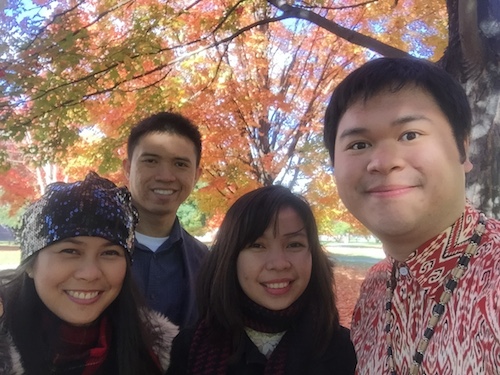
Gilbert Que’s The Role of Post-‐1990 Bollywood Films in Identity Formation of Second-‐Generation Indian Transnationals in Metro Manila uses Bourdieu's notion of economic capital, the social capital, and the cultural capital, to explore the impact of post–1990 liberalization Bollywood films on the lives and identities of second-generation Indian transnationals in Metro Manila, the Sindhis and the Punjabis. The study revealed how Bollywood is popular among these Indian transnationals. In addition, despite the differences between NRI-(non-Resident Indians) targeted and internationally-targeted Bollywood films, the respondents learned Hindu values and cultures from both groups of films, and when to start questioning the norms. Finally, these Bollywood films made the respondents proud to be Indians not only because of the nationalistic themes in the films, but also because the creativity of the Indians has allowed the world to notice and take an interest in India. Mr. Que’s paper was part of a panel, “Politics of Identity in Film.”
In “New Chinese Migration and their New Quest Away from their Homeland, Ivy Ganadillo shows how the continuous influx of Chinese to different countries from 1978, when China adopted an Open Door Policy, led to the phenomenon of the “New Chinese Migrants” (NCMs) or Xinqiao. Following the World Migration Report from the International Organization on Migration, she argues while Chinese migration to the Philippines can be described as a “South-South” dynamics where the flow of migrants moves from a low-income to another low-income economy, their life experiences and personal stories are considered a “blind spot” and an understudied area that equally needs to be explored. In the study, Ms. Ganadillo attempts to provide an objective description of the increasing number of New Chinese migrants; and to reveal the social and normative factors that influence their decisions to leave China and settle in the Philippines. Her paper formed a panel, “New Landscape Created and Perceived.”
Latasha Carreon’s Beauty Culture: As an Arena of Conflict between the Chinese Feminists and the Party aims to explore how Chinese women have reacted to beauty culture in China that feminists are strongly against but the Party is promoting. Today, in contemporary urban China, it has been observed that women now are busy with making themselves attractive, which is seen by the Party as a positive trend because this “beauty culture” allows women to fulfill their role in reproduction (Croll 1995, as cited by Leung, 2003). It must be noted, however, that unlike from its Western counterparts, feminism in China is under the control and protection of the government; indeed, it is the State who constructs what is meant to be a ‘man’ and ‘woman’ in Chinese society. Even so, the conflict between state-feminism, as it were, and the Party has ensued. Ms. Carreon’s paper was part of a panel on “Gender Politics in China.”
Janus Isaac Nolasco presented a paper, “The Philippines Meets World: The Global Turn in Contemporary Philippine Studies” as part of a panel on “Nationalism and National Identities in Asia.” Using the Philippines as a case study, his paper shows how Philippine Studies over the last few decades has taken on a “global turn,” in which scholars have increasingly looked at the Philippines from a regional and global perspective. Mr. Nolasco also describes how scholarship on the country has been produced abroad, not just by foreign scholars but Filipino academics who have migrated to the United States, among other countries. Providing an overview of recent studies that exemplify the global turn, Nolasco posits seven interrelated causes of the global turn and charts how global-turn scholarship departs from and relates to previous studies in the field. And while his paper provides a framework in tracing an intellectual history of Philippine Studies, it also offers a case study of how a globalizing Asia impacts knowledge production on a national level.
 Latasha Carreon is majoring in China Studies for her MA in Asian Studies at the UP Asian Center, as is Ivy Ganadillo, who is also University Research Associate and works at the PhD TriCollege Secretariat. Gilbert Que is an alumnis of the UP Asian Center who now teaches courses on Asian history and on Bollywood at the Ateneo de Manila University. Janus Isaac Nolasco is University Researcher at the UP Asian Center, and Managing Editor of Asian Studies: Journal of Critical Perspectives on Asia.
Latasha Carreon is majoring in China Studies for her MA in Asian Studies at the UP Asian Center, as is Ivy Ganadillo, who is also University Research Associate and works at the PhD TriCollege Secretariat. Gilbert Que is an alumnis of the UP Asian Center who now teaches courses on Asian history and on Bollywood at the Ateneo de Manila University. Janus Isaac Nolasco is University Researcher at the UP Asian Center, and Managing Editor of Asian Studies: Journal of Critical Perspectives on Asia.
For more information on the New York Conference on Asian Studies, visit the conference website and download the conference program.
The Asian Center offers M.A. degrees in Asian Studies with four fields of specialization: Northeast Asia, Southeast Asia, South Asia, and West Asia. The Center also has an M.A. program in Philippine Studies that allows students to major in Philippine society and culture, Philippine foreign relations, or Philippine development studies. The Center offers a Ph.D. program in Philippine Studies in conjunction with the College of Arts and Letters and the College of Social Sciences and Philosophy. For an overview of these graduate programs, click here. The Asian Center also publishes Asian Studies: Journal of Critical Perspectives on Asia, the latest issue of which can be downloaded at the journal's website. View recent and upcoming Lectures & Conferences and read other News & Announcements. Join our mailing list.

